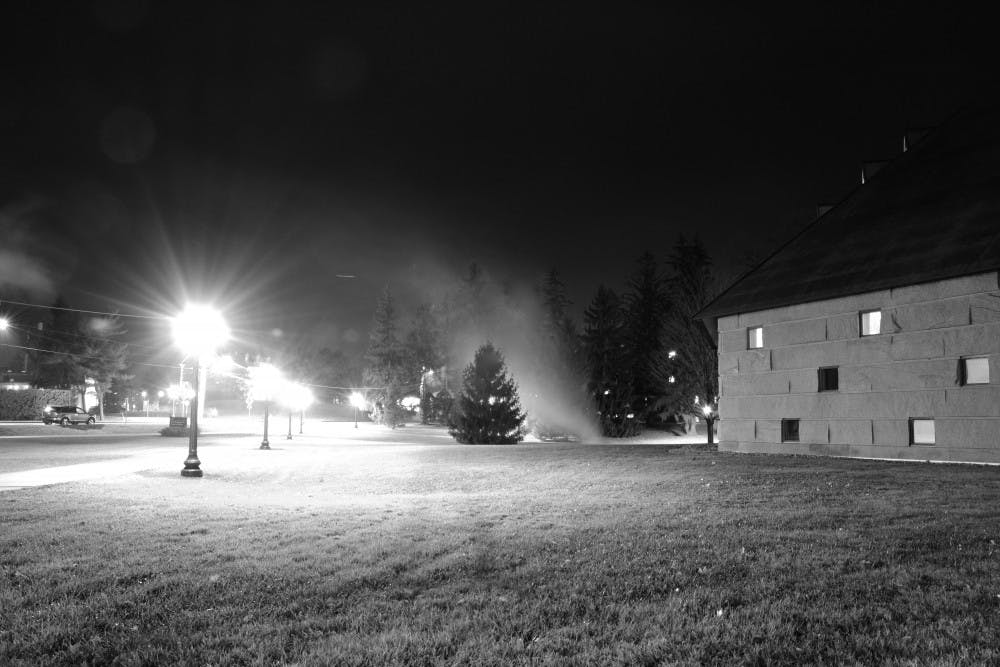Ever wondered about the mysterious “steam” coming out of the in-ground grate near the Mahaney Center for the Arts? (Hint: it has to do with something that Google headquarters and Middlebury College have in common).
“I have no idea,” Emma Hamilton ’17 said. “Is it a snow melter?”
“Well, it doesn’t smell,” Daniel Plunkett ’16 guessed. “I would assume its steam from the biomass plant. I don’t think there’s anything happening in the CFA that requires exhaust.”
“It’s steam, right?” Maya Woser ’18 echoed Plunkett’s prediction. “I don’t think it can be hot air. That just sounds dangerous.” But it is!
“It’s not steam (that’s being emitted from the grate),” supervisor of the College’s Heating, Ventilation and Air-Conditioning system (HVAC) Raymond Gale said. “If you walked on there [the grate], you’d see it’s just hot air, only about 110 degrees or so.”
I walked on, and felt I had stepped into a sauna.
“When the air is cool, like this time of year, it just saturates the (surrounding)air with moisture, which makes fog,” Gale said, as I quickly wiped my sweat (fog?) ‘stache.
The whole underground contraption is part of the CFA’s air-conditioning system.
“Inside the building is what’s called a chiller,” explained Gale, and that hot air is what comes out of the grate. “It pumps chilled water around to different areas and it picks up heat as it goes through the building. The pipes take the water back into the chiller, and the chiller transfers the heat into the cooling tower. There’s a fan that blows hot air up through the water so it takes the heat out.”
Built in 1989, the chiller air-conditioning system runs almost year-round, from March to December, in order to maintain the humidity and temperature in the Museum’s galleries.
“Even when it’s fifty degrees outdoors, you need the chilled water to remove moisture from the building,” Gale said.
Most of the air-conditioned buildings on campus are not water-based but Freon-based and use DX coils and gas compressors. The cooling tower system is preferred for larger buildings because it is more efficient and more effective in cooling (measured in tonnage), than the Freon system, which is also a larger structure.
However, the water-based system uses more chemicals.
“The cooling tower needs a lot of maintenance, a lot of water treatment,” Gale said. “The water is warm and at a good temperature to grow bacteria, so you have to treat it daily with chemicals. The other [Freon-based] system is all internal, it’s all locked in. There’s no treatment.”
The chemicals used to treat the water are a microbiocide, A-202, and bromine. The microbiocide is biodegradable, according to Gale.
“We’ve switched [the chemicals] up from when I came 20 years ago,” he said. “We used to have chemicals that, when they went into the sewer to the treatment plant, messed up the [sewer treatment plant’s] bacteria. So we switched to biodegradable chemicals that don’t mess with the bacteria.”
There are also chiller systems installed in the Johnson Memorial Building and in BiHall.
“At certain times, if you look at the top of McCardell Bicentennial Hall you’ll see a plume coming up from there,” Gale said. “The CFA’s cooling tower is underground for aesthetic reasons, according to Gale. “There’s no place to put the cooling tower on top of the roof due to its shape and structure.”
In the near future, the chiller system in Johnson might be renovated into a new HVAC system that uses geo-thermal energy.
“The College is really going towards efficiency. Over by Battell Hall, they would drill all kinds of wells and use the local town water,” Gale said.
Although Gale is optimistic about the College’s commitment to sustainability, he has a few qualms about the 500 individual window air-conditioners they install each year for the summer language school students.
“It doesn’t seem very green to me,” Gale said. “Students often turn on their air conditioners and leave their windows open. They like to keep their room 70 degrees, rather than 75.”
The campus set points for cooling are 75 degrees and for heating 70 degrees. “We’re working towards a standardized AC system for some dorms,” he said.
And so, as another Vermont winter approaches, if you ever need to defrost your nose at the end of the long trek from BiHall to the CFA, this “foggy” grate is arguably the biggest hot spot on campus.

Behind the Vest: Mysterious CFA Vent Isn’t Blowing Off Steam

Comments


